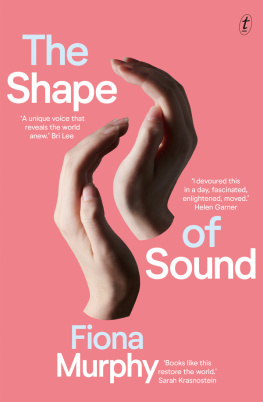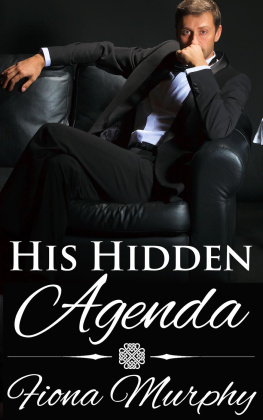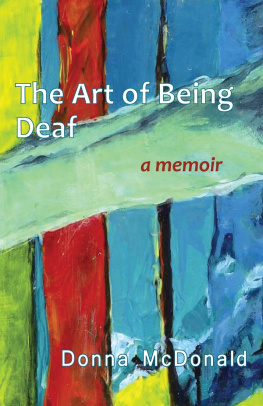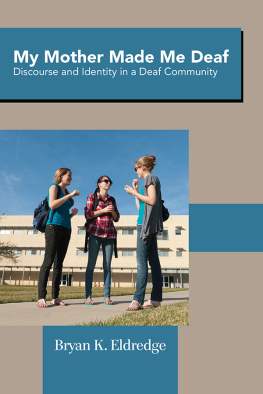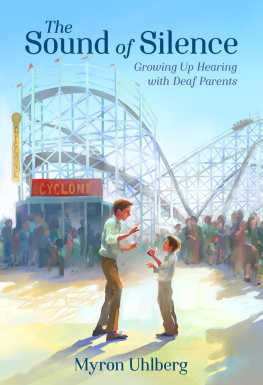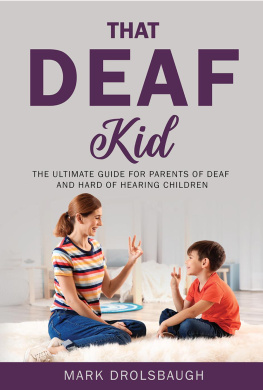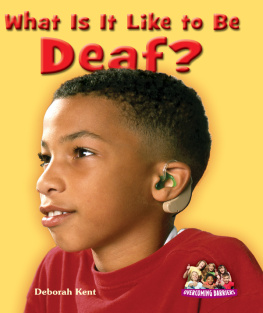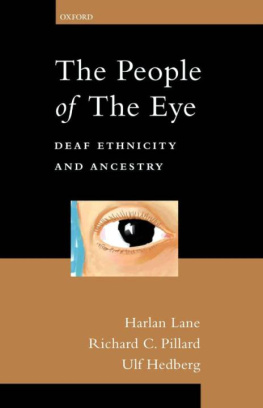I am still unlearning the habit of secrecy. And yet, whenever somebody discovers that I am deaf, my body still reacts with churning terror. How do you build up a sense of robust pride when your body has taught itself to be fearful?
Fiona Murphys memoir about being deaf is a revelation.
Secrets are heavy, burdensome things. Imagine carrying a secret that if exposed could jeopardise your chances of securing a job and make you a social outcast. Fiona Murphy kept her deafness a secret for over twenty-five years.
But then, desperate to hold onto a career shed worked hard to pursue, she tried hearing aids. Shocked by how the world sounded, she vowed never to wear them again. After an accident to her hand, she discovered that sign language could change her life, and that Deaf culture could be part of her identity.
Just as Fiona thought she was beginning to truly accept her body, she was diagnosed with a rare condition that causes the bones of the ears to harden. She was steadily losing her residual hearing. The news left her reeling.
Blending memoir with observations on the healthcare industry, The Shape of Sound is a story about the corrosive power of secrets, stigma and shame, and how deaf experiences and disability are shaped by economics, social policy, medicine and societal expectations.
My memoir is as true as I can recall. The names and identifying characteristics of some people have been changed to respect their privacy.
Identity is a fluid concept and a personal choice. Lowercase deaf refers to deafness as a medical condition. It does not indicate the degree of hearing loss an individual may have. Some people with hearing loss may prefer to use the term hard of hearing. Uppercase Deaf refers to people who identify as culturally Deaf and may use sign language. Given the ongoing suppression of sign-language education, not all Deaf people are fluent signers or even have access to the Deaf community. Again, this word does not indicate the degree of hearing loss an individual may have.
In music, the lifespan of a sound is described in the following sequence: attack, decay, sustain and release.
The body is a disjointed poem of mixed metaphors and similes. The spinal cord lashes out in a wild tanglecauda equinathe horses tail. Blood flows through the hearts atrium, the communal space in ancient Roman houses where the hearth burned hot and bright. In the wrist lie two rows of irregular bones, including the lunate, scaphoid and hamateor the crescent moon, the boat and the hook. The ear cradles the smallest bones in the human bodythe malleus, incus and stapesall three can sit together on your fingertip like a speck of dust. Lean in close and youll see their quiet, decisive strength: the hammer, anvil and stirrup. In motion they beat and thump the eardrum. In stillness their story continues, nevertheless.
My deafness became unmissable when I was learning to swim. Every week, from when I was five until I was seven, Mum took me to swimming lessons at the local community centre in Villawood, Western Sydney. At just twenty-five metres long, the indoor swimming pool was usually crammed with bodies, and the chlorinated air was stifling.
I would bob along by the edge, never wanting to be more than an arms length from safety. The swimming instructor gathered her handful of students into the shallow end, where our feet could almost touch the tiles on the bottom. Her torso rose high out of the water, so, even now, I cant picture her face. She taught us how to kick off from the wall and rocket forwards, our arms and legs stretched long. Mostly, I just remember hopping on the spot, trying to keep my feet in contact with the tiles.
Eventually the instructor approached Mum and said that I seemed to be having trouble hearing, that I rarely followed her instructions and was either in distress or drifting aimlessly through each lesson.
Over two decades on, my body is still not calm in water. Im proficient at swimming, but I feel unanchored and exposedand my deafness remains unmissable.
Sound travels in waves. More often than not, when people actually hear sound its at the moment of impact: when waves collide with the ear drum. This is the noisiest, most insistent part of sound. But what about before then? What about the build-up of all that energy and motion? Silence can be just as chaotic and momentous.
Sound is more than noise. In the same way as no one ever thinks of the sea as being simply the shoreline. The sea is wider, deeper, more complex than waves whumping against rock or sand. So why are sound waves only ever talked about as noise?
The prevailing assumption is that deaf people hear nothing, that they dont experience sound at all. Silence is often described as thick, blanketing, golden, constricting, suffocating, oppressive, impenetrable. These are the words I use when I talk about sound.
I feel sound rolling over my skin. I see it shimmer off other faces. I taste it in my mouth. Sometimes, it is all too much. I grab onto walls, back myself into corners and try not to be pulled under.
I was born in 1988, three days before the First Fleet Re-enactment Voyage sailed into Sydney Harbour, marking two hundred years since Invasion Day. As Mum was labouring in Bankstown hospital with her last child, the doctor suggested that she hold on, try to coincide my birth with the birth of the nation. She thought he was a fool.
By the age of five, I could rattle off the alphabet with singsong ease. Id rove around the house annoying my two brothers and sister by reciting the letters as fast as possible. Quicker and quicker, until the letters stuck together.
In Year One at Burwood Public School, in Sydneys inner west, we were taught to keep our copybooks neat and tidy with the days date recorded in the top right-hand corner, followed by a heading in capital letters. Towards the middle of that year, our teacher started giving out demerit points if we were messy or careless. The tip of my pencil hovered uncertainly in the air whenever she reeled off instructions. My copybook stayed neat, as most pages were left blank.
We would also get demerit points if we didnt put our hand up before asking a question, or if we were caught talking when we should have been working. The points were tallied on a large poster. Three demerits and youd have to pick up rubbish in the playground. Not wanting to risk getting into trouble, I stayed quiet whenever we had to pull out our copybooks. Id crane my neck, looking around the table to decipher what everyone was writing. If I couldnt figure it out, Id draw pictures or arrange my pencils in neat rows, waiting for lunchtime.
In Year Two, instead of pictures on the classroom walls, there were charts of fractions and long words. And no crates of soft toys or building blocks. We sat at our desks for most of the day, only allowed to play during lunch break. Flecks of rubber lay scattered across my desk as I erased mistake after mistake.
At the back of the classroom there was a box of large cards. During reading-time, we had to select a card. Each one contained a short story, two or three paragraphs long, and sometimes a picture as well. There were questions on the card and we had to write the answers in our copybooks. Unable to read anything other than my name, I would trace my finger over the curved marks that looked like hooks.
A few weeks into the school year, Mum took me into the city. As the train carried us through endless suburbs, she told me that I was going to play a few games and then an audiologist would check my ears. Years later, I found out that my teacher, having noticed my blank copybook, suggested I be tested for a learning disorder. This, as well as my swimming instructors concerns about my hearing, prompted Mum to book an appointment with a child-development clinic.

